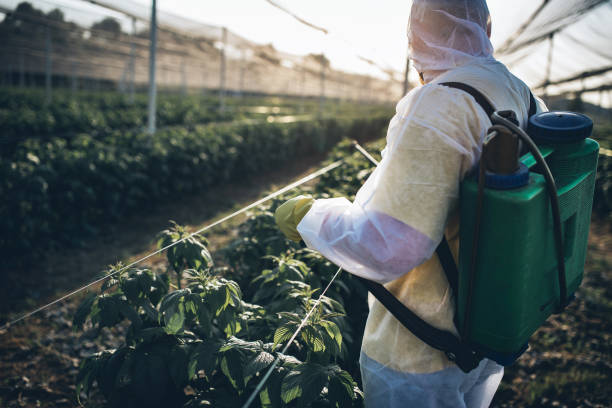The Agrochemicals Issue in Costa Rica

What is the situation of agrochemicals in Costa Rica? What is the reason for their use? Find out in this article.
Last March of this year, a new source of water contaminated with agrochemicals was discovered.
This analysis was made by the Regional Institute for Studies on Toxic Substances of the National University, which detected the chemical chlorothalonil in the Carlos Martinez water source in Oreamuno, Cartago.
In addition, the same chemical appeared in February in the springs near Cipreses de Cartago.
What is chlorothalonil?

According to the United Nations Development Program (UNDP) study entitled “Apparent Use of Pesticides in Costa Rica”, chlorothalonil is the fourth most widely used fungicide in the country. It has an average of 861 thousand kilograms per year, 983 registrations in the country and 586 commercial registrations for use on vegetables.
Chlorothalonil is a fungicide, i.e. a product that can eliminate fungi that attack plants. It is also very persistent in the environment, which has a negative impact on the natural environment.
Some of its characteristics are: stable at any temperature, not very soluble, highly persistent in water, immobile and non-volatile).
What are its negative effects?
As mentioned above, this fungicide has been found in drinking water sources intended for human consumption. Indeed, chlorothalonil has toxicity characteristics for aquatic organisms, birds, bees and earthworms. Also of concern is the possibility of bioaccumulation in mammals (i.e., the fungicide molecules accumulate in the bodies of animals to the point of causing them harm). In addition, this fungicide is recognized as highly toxic and aggressive to fish and amphibians.
And what about human health? Chlorothalonil also affects humans. Indeed, it is a probable human carcinogen, has the potential to be an endocrine disruptor and generate developmental defects in embryos.
In fact, the Agricultural & Environmental Research Unit made a specific compilation of the health concerns and problems generated by chlorothalonil that can be simplified as follows:
Chlorothalonil is a cause of concern for
- the possibility of carcinogenicity
- the possibility of being an endocrine disruptor
- have effects on reproduction and development
- be an irritant to the respiratory tract
- be an eye irritant
- be a dermal irritant
- be a skin sensitizer
Chlorothalonil in the European Union and Switzerland
This fungicide was recently banned in the European Union precisely because of its toxicity, its potential to be carcinogenic and to contaminate groundwater sources. In addition, Switzerland has categorized chlorothalonil as carcinogenic type 1B (i.e. it is likely to be carcinogenic to humans).
Even under these measures, small particles of chlorothalonil are expected to continue to pose a harm to Europe’s drinking water due to their persistence in the environment. Similarly, in Switzerland, attempts have been made to sanitize water contaminated with the fungicide and its particles, but have not been properly evaluated.
So, why is chlorothalonil used in Costa Rica?
If chlorothalonil is so toxic to species and if it was banned in the European Union, why is it still used in Costa Rica?
The use of agrochemicals in the country is one of the most important national problems, even more so when Costa Rica paints itself green.
The reality is that, according to data from the World Resources Institute, Costa Rica is the largest consumer of agrochemicals in the world. Moreover, according to the Organization for Economic Cooperation and Development (OECD), the country uses about 20 of the most dangerous pesticides in the world.
Agriculture: an important role

Why is this? First, we must remember that agriculture is, since colonial times, one of the most important sectors for Costa Rica. For the country, the cultivation of coffee, bananas, pineapple and sugar cane is of great importance, since they are considered part of the basic food basket and are also exported to other countries (especially pineapple and bananas). In fact, the World Integrated Trade Solution ranked pineapple and banana among the 5 most important export products of Costa Rica in 2020.
Then, as agriculture is of great importance in the country, these cultivations must be protected from pests (insects, plants and fungi) and this is when agrochemicals enter the situation. It can be deduced from the attitude of these production companies that selling is worth more than the environment in which both people and animal species live.
In fact, one of the latest controversies was melons contaminated with chlorothalonil in proportions that exceeded 7 times the limit established by the European Union. These melons were exported to Europe and alerted the German government, which warned its inhabitants of the possible risk of cancer from consumption of the fruit.
Are there environmental policies regarding this?
As a result of these situations, the Ministry of Environment and Energy (MINAE), the Ministry of Health and Aqueducts and Sewerage (AyA) recommended, through a technical report, to prohibit the use of chlorothalonil in Costa Rica.
This report calls for more safety measures in the agricultural sector: less exposure of workers to products that are harmful to health and more protection for the environment and the health of the population.
Since 2017, there had been talk of a new system on the part of the government that would allow for greater ease in registering agrochemicals arriving or being used in the country.
However, we are in 2023 and this kind of thing is still happening. So, is the State really willing to take measures to protect the environment, water and its population?
Sensorial Sunsets
Navigate articles





